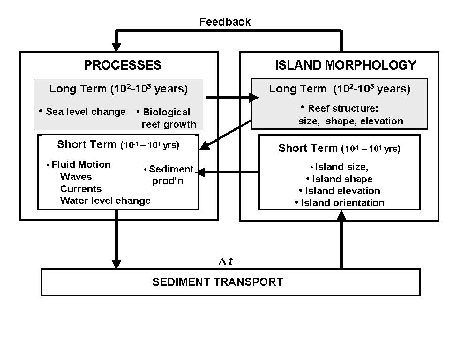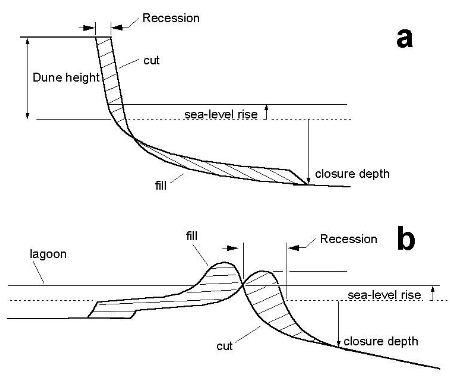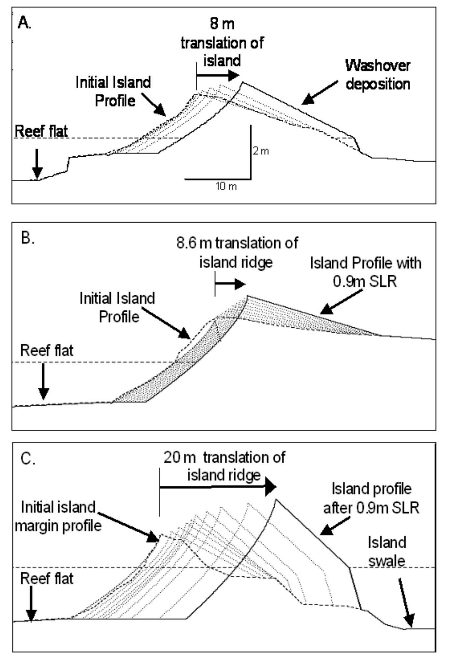Tiempo Climate Cyberlibrary
Erosion of Low-lying Reef Islands
- Tiempo archive
- Complete issues
- Selected articles
- Cartoons
- Climate treaty
- Latest news
- Secretariat
- National reports
- IPCC
About the Cyberlibrary
The Tiempo Climate Cyberlibrary was developed by Mick Kelly and Sarah Granich on behalf of the Stockholm Environment Institute and the International Institute for Environment and Development, with sponsorship from the Swedish International Development Cooperation Agency.
While every effort is made to ensure that information on this site, and on other sites that are referenced here, is accurate, no liability for loss or damage resulting from use of this information can be accepted.
  |
Paul Kench and Peter Cowell present methodological developments in assessing the effect of sea-level rise on the erosion of low-lying reef islands. Paul Kench is Senior Lecturer in the School of Geography and Environmental Science at The University of Auckland, New Zealand. Peter Cowell is Senior Lecturer in the Coastal Studies Unit, School of Geosciences, at the University of Sydney, Australia. |
The plight of Small Island States has focused global attention on the impacts of global climate change and, in particular, sea-level rise. Over the past decade, numerous vulnerability assessments have been undertaken in Small Island States. Most are unequivocal in highlighting the extreme physical, social and economic vulnerability of these islands and their people.
Underpinning statements of island vulnerability are assertions that erosion of island shorelines will promote significant changes in island size, elevation and area or even total loss of islands. Other physical impacts widely cited include increased flooding and changes in size of island groundwater systems (both of which are affected by physical changes in islands) and reduction in reef productivity. Such impacts pose serious management issues. In extreme cases, the environmental consequences of climatic change on physical resources of islands (land and water) are widely considered sufficient to make islands uninhabitable and reduce entire nations to environmental refugees.
These extreme scenarios have captured popular media attention and have been promulgated through some scientific literature. As a consequence, it is common to hear and read statements that “entire island nations and cultures may be lost” as a result of sea-level rise.
How robust are assessments of erosion in small islands?
While erosion is widely cited as an impact of heightened sea level, few studies have provided quantitative assessments of the magnitude of erosion or the likely mode of physical response of low-lying reef islands to sea-level rise. Most assessments are bereft of critical analysis of how islands change, data on shoreline behaviour or rigorous projections of island response and as a consequence are largely speculative.
This situation can be attributed to a number of related factors. While international focus on the plight of atoll islands has increased over the past decade, there has, paradoxically, been a near absence of new research to understand the boundary conditions that control island development and change. Consequently, there is a poor theoretical framework of how islands will respond to sea-level rise and, as a result, a dearth of tools to assist countries undertaking erosion impact assessments.
The lack of quantification of erosion and how it is manifested in small islands is a major constraint to development of adaptation strategies. Given the overwhelming prognostications of doom for small island nations, it is vital that erosion impacts are better resolved to either confirm or disprove extreme scenarios of total island disappearance.
This article summarizes research, stimulated by the 2000 World Bank Regional Economic Review, into the impacts of sea-level rise in the Pacific. The study is limited in scope to the lowest-lying reef islands. Concepts of island morphological change are evaluated in light of common perceptions of vulnerability and new methodological developments are outlined that allow more robust assessments of the physical response of reef islands to be evaluated.
Controls on reef island formation and change
Atoll and reef islands are coherent accumulations of sand and gravel-size material derived from broken-down remains of corals, algae and other reef-dwelling organisms. The presence and morphological characteristics of islands, such as area and elevation, result from the balance between sediment supply, marine processes that transport sediments (for example, waves, currents and storms) and available space for deposition. The maximum elevation of these islands is generally governed by the height to which storm waves can deposit sediment. The mean elevation, however, is generally less than one metre above mean sea level.
Reef islands are dynamic landforms. Relationships between sediment supply, processes and reef platforms are summarized in Figure 1 in a conceptual model of island morphodynamics. A change in any one factor will promote change in the shape, size and elevation of an island. Of interest to impact assessments are the effects of these different factors and the timescale over which islands can adjust their morphology.
|
|
|
Figure 1: Conceptual model of reef island morphodynamics. |
Most vulnerability assessments adopt a simplistic analysis that links raised sea level with an increase in elevation of wave attack at the shoreline, which promotes erosion. As shown in Figure 1, island response is more complex with changes in sediment supply or alteration in processes also able to promote changes in island morphology in the absence of sea-level change. These other factors are seldom identified in vulnerability assessments. Yet the history of most small island states is littered with examples of islands growing in size (accreting), eroding away or fluctuating in size in response to changes in storm energy or monsoon winds. These historical analogues serve to highlight the fact that islands undergo significant short-term changes in morphology in response to changing environmental conditions.
Coastal erosion, defined as the long-term loss of land, is a natural process that has been occurring throughout the history of most small island nations. Of importance to vulnerability assessments is to establish whether erosion is being exacerbated by rising sea level. However, few small island nations have established systematic national coastal monitoring networks that are able to furnish unequivocal determinations of erosion or accretion rates. This is, perhaps, one of the least expensive actions that small island nations could take to develop a robust and quantitative framework to support assertions of eroding shorelines.
It is also pertinent to note that island erosion has been exacerbated in many islands as a result of inappropriate human interaction and management. The building of causeways (for example, to link islands), insertion of groynes, seawalls, sand extraction and harbour developments are all activities that have promoted erosion. It is interesting that such effects are largely unreported in the assessment of the effects of climate change on small islands.
Existing tools and methodological developments for erosion assessment
The United Nations Environment Programme’s Handbook outlines only one model, the Bruun Rule, for assessing erosion on sandy coastlines. This model predicts that as sea-level rises the shoreline strives to maintain an equilibrium beach slope. It achieves this by eroding material from the shoreline and spreading this material across the seabed, see Figure 2. Consequently, the nearshore profile maintains a constant elevation with respect to sea level at the expense of sand stored at the shoreline, which promotes erosion.
|
|
|
Figure 2: Models of shoreline response to sea-level rise. A) The Bruun Rule, B) Rollover model otherwise known as the Generalized Bruun Rule. |
While the merits of the Bruun Rule have been widely debated in scientific literature, its simplicity and ease of use have meant it remains the most common tool used to assess shoreline change.
A basic assumption of the Bruun Rule is that the height of the coastal margin is greater than the elevation of storm surge so that material eroded from the beach is transported offshore. This assumption is invalid in most low-lying reef island environments. As noted earlier, the highest land elevation on many reef islands is deposited by extreme water levels. During extreme storms it is common for waves to break and travel across an island surface. Such action allows sediment to be transferred from the beachface to the island surface or lagoonward shoreline. This process is referred to as ‘washover’ and contributes to progressive rollover of small islands.
Recognizing the limitations of the Bruun Rule for low islands, a new methodological approach was adopted that more faithfully captured the physical processes governing reef island morphology. The Shoreface Translation Model (STM) was adapted for application on reef islands. It was originally developed to simulate the development of sand barriers on continental coastlines. The model is, therefore, flexible in taking into account shoreline elevation, gradient and maximum storm-building water level and is able to simulate washover processes, which are critical in reef island development and change. The model was adapted to account for near horizontal and non-erodable reef surfaces which underlie most reef islands, and to account for short truncated beach profiles. Concepts underlying the model were also re-evaluated in the context of reef island settings.
The modified STM has been applied to reef island settings in Kiribati and the Maldives. At a practical level, the model requires a minimum of information. Topographic surveys of the coast are required together with estimates of the maximum storm building level. Where water level records are not available, anecdotal evidence provides sufficient information to establish whether washover occurs and the frequency of such events. The model simulates equilibrium shoreline change at user-defined sea-level rise increments. The user is also able to change sediment inputs.
|
|
|
Figure 3: Sample results of STM simulations for reef islands. A) Low island rollover with a 0.5 m increase in sea level, Buariki Island, Kiribati. B) Shoreline translation of a high elevation shoreline under a 0.9 m increase in sea level, Fuah Mulak, Maldives. C) Rapid shoreline translation of a low elevation island margin, Dhekamba Island, Maldives. Initial morphology = dark dashed line. Final morphology = solid black line. Intermediate dashed lines = transitional morphologies at 0.1 m sea-level rise increments. |
Sample results of the STM modelling are presented in Figure 3. All simulations show that sea-level rise promotes physical changes in island shorelines. However, shoreline change does not always result in erosion or net loss of land. In low-lying and narrow islands, total washover promotes ‘rollover’ of islands. The total land area remains relatively constant but the island migrates on the reef platform away from the reef edge. In essence, the island strives to achieve a new equilibrium position on the reef platform with altered water level and wave and current conditions on the reef top. On wider islands, complete washover does not occur but is limited to the seaward edge. This results in a reworking of sediment into a sand ridge that rolls-back across the island margin and, in turn, net erosion of the shoreline and island narrowing.
The magnitude of shoreline displacement is small. Simulations on over fifteen reef island settings found maximum shoreline erosion between three and thirty metres for a one metre increase in sea level. Importantly, no simulations identified total loss of islands.
Washover allows sediment to be transferred to island surfaces allowing island margins to be built upward with sea level. This implies that not all sediment is lost to the island but contributes to raising of island ridges. The mode and magnitude of response varies depending on shoreline morphology at a given location. Higher elevation coastal margins and wide islands appear to be most stable with greatest amounts of erosion/instability occurring on the lowest lying islands.
Model simulations presented in Figure 3 involve only a change in sea level. Changes in a number of other factors can also influence island morphology (Figure 1). It is widely assumed that reefs are biological factories that produce abundant supplies of sediment to sustain or maintain island shorelines. In reality, there have been few quantitative studies of the rate of sediment generation on coral reefs of sediments of a size suitable to contribute to islands, such as sand and gravels.
Intuitively, sediment production on reef flats is dependent upon the likely reef response to sea-level rise. Though the subject of vigorous debate, the weight of opinion suggests that the reef-building capacity of corals may decline as climate and sea-level changes. Typically, the prognosis for coral reefs is directly linked to the fate of reef islands. In our opinion, such a link requires a leap of faith which at best is untested and at worst misleading for two reasons. First, the assumption that contemporary reefs generate ample supplies of sediment to contribute to island building and maintenance has not been validated. Few studies have attempted to quantify rates of sediment production and its contribution to islands so our understanding of sediment generation is limited. Second, based on this poor understanding of reef flat sediment generation, the link between possible future reef response and changes in sediment production (that contributes to island building) is unknown.
Most recently, the modified STM has been used to explore how alterations in sediment supply combined with sea-level rise influence shoreline change on atoll islands. In lieu of studies that quantify rates of sediment generation, well-known values of reef productivity were combined with assumptions of the proportion of this material that may realistically produce material suitable for island building. Construction of these scenarios indicated that under current conditions reef systems produce small quantities of sediment that contribute to island shorelines.
Reefs of the Pacific have been close to their vertical limit of growth for the past 6,000 years and this has promoted a decline in reef productivity. This is supported by geological investigations of island shorelines that fail to identify modern sediments on reef island beaches. Furthermore, sea-level rise will lead to a reduction in the generation of sediment on coral reefs. Increased sea level will exert a pressure on coral reefs to grow. Under these circumstances it is likely the reef will retain more calcified material as reef framework rather than release it as loose sediment.
Estimates of reduced sediment supply were scaled over the next century and applied in STM simulations of island behaviour. Results of this work indicate that, as current rates of sediment generation are low, any future physical response of islands will have to occur using finite, that is, existing, reserves of sediment. Furthermore, reduced sediment supply will, as expected, increase the rate of shoreline displacement or erosion. However, erosion rates are still relatively minor with respect to total island width.
Greatest changes in island stability were simulated by significantly altering the amount of sediment that is transported alongshore. For example, alongshore removal of up to 0.4 m3 of sediment per year increases the local erosion rate by an order of magnitude. Islands may significantly reorganize sediment reserves with rapid erosion in sensitive areas and consequent rapid deposition elsewhere.
Changes in alongshore sediment transport may be caused by subtle shifts in approach of ocean swell and their subsequent interaction with reef platforms to produce reef top currents. However, understanding of the influence of climate change is poor. Human interaction, such as sand extraction and insertion of hard engineering structures, is also capable of substantially altering sediment transport.
These results underscore the importance of existing sediment reserves in reef island maintenance and indicate that island nations should make conservation of island and nearshore sand resources a high priority.
Conclusions
The modified STM is a new methodological tool that can be used to assess the physical response of low reef islands to sea-level rise. The model is easy to apply, does not require large datasets and can be applied at numerous locations over a short timeframe. Importantly, the model also captures the known behaviour of low-lying reef islands.
Simulations undertaken to date indicate that reef islands will physically adjust to sea-level change and will not totally disappear from reef platforms given current sea-level scenarios.
Importantly, simulations also show that changes in sediment supply and transport can also cause physical alteration of small islands by an equivalent or greater magnitude than sea level alone. These preliminary findings underscore the sensitivity of reef islands to changes in a range of environmental variables.
While the study does not project wholesale devastation of low-lying reef islands, it would be incorrect to infer that small island nations should not be concerned about the possible consequences of sea-level rise. On the contrary, rates of erosion up to thirty metres and washover deposition of sediments pose significant management issues for island nations where the coastal margin is commonly heavily populated and contains high-cost infrastructure.
Increasingly small island nations are being asked to develop adaptation strategies to the impacts of climate change. The STM does not solve the difficult issues of how to adapt to change. Rather the modified STM provides better resolution of the mode (for example, washover, rollover) and magnitude of island response to which adaptation will be necessary.
STM simulations have highlighted issues of physical island response that have previously not been identified in vulnerability assessments and provide clear definition of the nature of changes to which management agencies will need to respond.
For example, rather than simply responding to poorly resolved estimates of land loss, managers will need to carefully consider:
- how communities will adapt to physical island instability and movement on the reef platform;
- how adaptation strategies will allow for washover processes to naturally raise island margins;
- how compatible ongoing development can be with island washover processes and what planning and regulatory tools would allow this to happen; and,
- how adaptation measures can be implemented to ensure that waves, currents and sediment transport processes are not affected.
Further information
Paul Kench, School of Geography and Environmental Science,
The University of Auckland, Private Bag 92019, Auckland,
New Zealand. Fax: +64-9-3737434. Email: p.kench
@auckland.ac.nz.
Peter Cowell, Coastal Studies Unit, Institute of Marine and
Ocean Sciences, University of Sydney, NSW 2006, Australia.
Fax: +61-2-93513644. Email: p.cowell@csu.usyd.edu.au.
Acknowledgement
This article is based on material presented at the 9th
International Coral Reef Symposium, Bali, Indonesia,
October 2000, and articles published in a special issue of
the Journal of Coastal Research in 2001.
Bright Ideas

General Electric plans to cut solar installation costs by half

Project 90 by 2030 supports South African school children and managers reduce their carbon footprint through its Club programme

Bath & North East Somerset Council in the United Kingdom has installed smart LED carriageway lighting that automatically adjusts to light and traffic levels

The United States National Oceanic and Atmospheric Administration and the American Public Gardens Association are mounting an educational exhibit at Longwood Gardens showing the link between temperature and planting zones

The energy-efficient Crowne Plaza Copenhagen Towers hotel is powered by renewable and sustainable sources, including integrated solar photovoltaics and guest-powered bicycles
El Hierro, one of the Canary Islands, plans to generate 80 per cent of its energy from renewable sources

The green roof on the Remarkables Primary School in New Zealand reduces stormwater runoff, provides insulation and doubles as an outdoor classroom

The Weather Info for All project aims to roll out up to five thousand automatic weather observation stations throughout Africa

SolSource turns its own waste heat into electricity or stores it in thermal fabrics, harnessing the sun's energy for cooking and electricity for low-income families

The Wave House uses vegetation for its architectural and environmental qualities, and especially in terms of thermal insulation

The Mbale compost-processing plant in Uganda produces cheaper fertilizer and reduces greenhouse gas emissions

At Casa Grande, Frito-Lay has reduced energy consumption by nearly a fifth since 2006 by, amongst other things, installing a heat recovery system to preheat cooking oil
Updated: May 15th 2015


